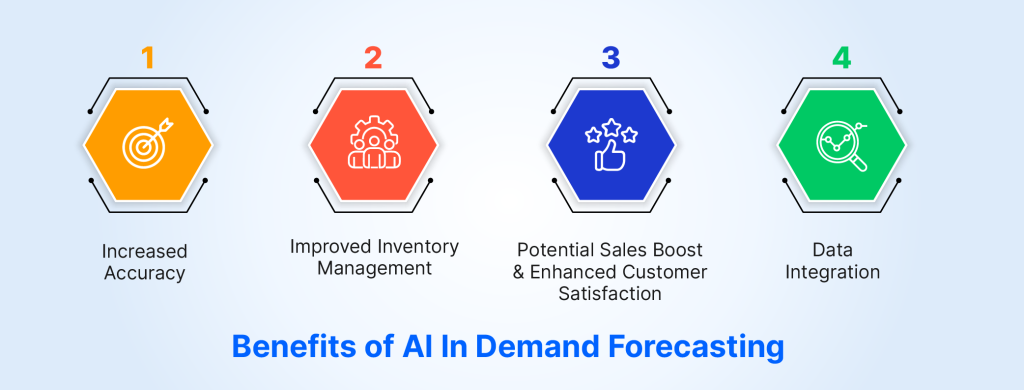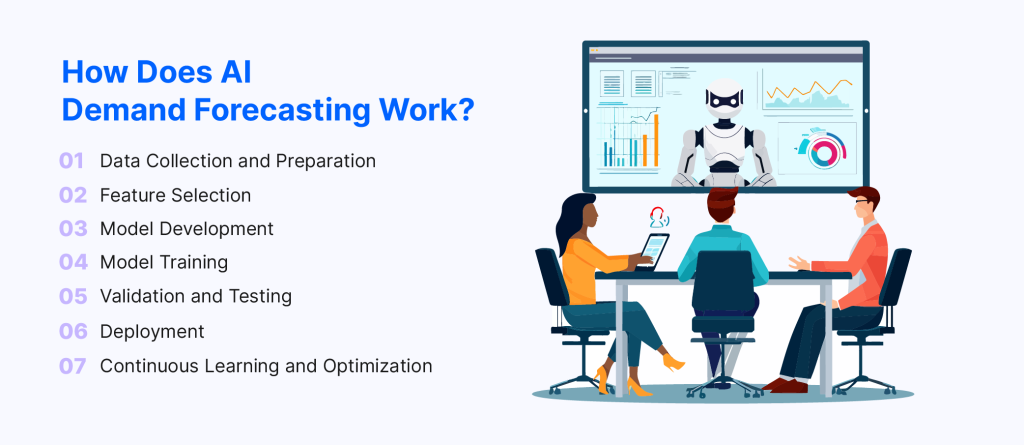When teams operate independently, it creates communication gaps that can lead to disorder. In contrast, when teams collaborate, they tend to be more efficient.
It’s difficult to ignore how AI is affecting practically every industry. And it doesn’t end there—machine learning has completely transformed daily operations in the retail industry. How? AI demand forecasting is the best option for revolutionizing corporate operations. Machine learning demand forecasting is a data-driven approach that utilizes algorithms to analyze historical sales data, market trends, and other relevant factors to predict future demand for products or services.
In the end, it alters how companies forecast client demand and allocate their assets. Retail seasoned professionals are certainly familiar with conventional demand forecasting techniques, but with the help of automation and artificial intelligence, they can predict future sales patterns much more accurately, which allows them to better manage inventory and staffing levels than in the past. This novel approach analyzes enormous volumes of data fast and precisely, going beyond conventional forecasting techniques. Retailers can now predict demand with a level of accuracy that was previously impossible.
AI demand forecasting has several advantages for several facets of retail operations. This technology helps organizations run more profitably and efficiently by minimizing overstaffing during slow periods and guaranteeing enough stock levels during peak periods. AI forecast models harness vast datasets to generate accurate predictions, guiding strategic planning and resource allocation.
AI demand forecasting refers to the use of artificial intelligence technologies, such as machine learning and deep learning, to predict future demand for products or services. This approach typically involves analyzing large datasets to identify patterns, trends, and correlations that can inform accurate demand predictions. AI foundation models can process complex and varied data sources, including historical sales data, market trends, consumer behavior, and even external factors like weather or economic indicators. AI-based forecasting solutions provide valuable foresight into future demand patterns, aiding in inventory management and production planning.
By employing AI in demand forecasting, businesses can achieve more precise and dynamic predictions compared to traditional methods. Implementing AI in demand forecasting opens up promising AI business ideas, revolutionizing how companies predict market trends and optimize their operations for enhanced efficiency and profitability. This enables more effective inventory management, optimized supply chain operations, and better strategic planning. AI-driven demand forecasting can adapt to changing conditions and continuously improve its accuracy through learning, providing significant advantages in rapidly changing markets.
AI changes the whole way companies make forecasts about the market situation and prognosticate trends. In opposition to normal or traditional methods that are based on historical data, AI systems are based on mighty algorithms and machine learning, examining plenty of data taken from very different sources. All this, if you put into consideration, and add all those multiple factors: sales data, market trends, activity on social media, and, yes, even weather patterns, then AI will be able to fish out complicated patterns and correlations that remained invisible in the past. This brings out the capability of AI in making better predictions and allows businesses to be at optimum levels in a position to optimize their stock levels, distribute resources in the right way, and finally respond well, in case of changes by the consumer. Again, AI allows for immediate analysis in cases where, when the market has changed or an opportunity has popped up, businesses need to be able to take action. In a broader perspective, AI in demand forecasting serves the role of offering businesses actionable insights to make improved, well-informed decisions and survive in the current market environment.
AI demand forecasting offers numerous benefits that can significantly enhance business operations and strategic decision-making. Here are some key advantages:

Legion’s solution, an AI demand forecasting system, makes use of machine learning algorithms to automatically evaluate past data in addition to external variables like the weather or promotional activities to produce precise forecasts. Your team members will have more time to concentrate on strategic company operations rather than tedious manual number-crunching thanks to the efficiency that automating this process brings. Significant cost savings can be achieved with a.5 labor cost decrease and a 1% increase in demand forecast accuracy. Machine learning demand forecasting enables companies to anticipate fluctuations in demand and plan accordingly. With AI forecasting, businesses can make data-driven decisions to meet customer demand efficiently.
With more accurate demand forecasts, businesses can optimize their inventory levels, reducing carrying costs and minimizing the risk of stockouts or excess inventory. This optimization leads to better cash flow management and cost savings. Incorporating AI in demand forecasting requires proficiency in programming languages such as Python and R to develop and deploy sophisticated algorithms for accurate prediction models.
In the contemporary market, where customers demand customized experiences together with instant satisfaction, it is imperative to have the appropriate product accessible at the appropriate time and location. Retailers may easily match these expectations by using accurate models driven by machine learning algorithms, which may raise customer satisfaction rates and improve overall sales performance. For more examples, see our use case on maximizing labor expenses with AI-based workforce planning techniques.
AI can handle and integrate various types of data from different sources, including sales data, promotional information, market trends, and external factors like weather or economic indicators. This integration provides a more holistic view of demand drivers.
Understanding consumer demand is vital in the retail industry. The key is to make sure you always have the ideal number of employees and merchandise on hand—not too little to cause missed opportunities or too much to result in waste. Accurate demand forecasting can help attain this difficult balance. AI demand forecasting models are becoming increasingly sophisticated, enabling businesses to optimize inventory and resources effectively. AI in demand forecasting can revolutionize industries by incorporating AI-based grading systems, enhancing accuracy and efficiency in predicting market demand and optimizing resource allocation.
AI-based forecasting tools offer businesses actionable insights into consumer behavior and market trends. AI demand forecasting typically follows a multi-step process that involves data collection, model development, training, and deployment. Here’s an overview of how it works:

The first step involves gathering relevant data that can influence demand. This data might include historical sales figures, pricing history, promotional activities, external factors like weather conditions or economic indicators, and even unstructured data like social media sentiment. Data preparation is crucial and includes cleaning, normalizing, and structuring the data for analysis.
The next step is to identify which variables or features are most relevant to predicting demand. This involves analyzing the data to determine which factors have the most significant impact on demand and should be included in the model.
Data scientists or analysts select appropriate machine learning frameworks based on the problem’s complexity and the nature of the data. Common choices include time series analysis models, regression models, deep learning networks, and ensemble methods that combine multiple models for improved accuracy.
The selected model is trained using historical data, allowing it to learn the patterns and relationships between different variables and how they impact demand. This training process involves adjusting the model’s parameters until it can accurately predict demand based on the input data.
Once trained, the model is validated and tested using a separate set of data (not used during training) to ensure it generalizes well and provides accurate forecasts on new, unseen data.
After validation, the AI model is deployed within the business environment, where it can start providing demand forecasts. These forecasts can be updated regularly as new data becomes available, allowing the model to refine its predictions over time.
AI demand forecasting models can be set up for continuous learning, where they automatically adjust and improve their forecasts based on new data and outcomes. This iterative process ensures that the model remains accurate and relevant over time, even as market conditions change.
At IntellicoWorks, we understand the transformative power of Artificial Intelligence (AI) and its potential to revolutionize businesses across industries. With our cutting-edge AI services, we offer tailored solutions designed to address your unique business challenges and drive growth. Our team of seasoned AI experts combines deep domain expertise with technical proficiency to deliver innovative AI solutions that deliver tangible results. What sets IntellicoWorks apart is our commitment to excellence and customer satisfaction. We prioritize understanding your specific needs and objectives, ensuring that our AI solutions are aligned with your business goals. Whether you’re looking to optimize operations, enhance customer experiences, or unlock new revenue streams, IntellicoWorks has the expertise and capabilities to help you succeed. AI development services play a crucial role in enhancing the capabilities of demand forecasting systems, ensuring businesses can leverage advanced algorithms and techniques to accurately predict market trends and consumer behavior. Although putting it into practice can seem difficult, it is possible if you carefully consider your present WFM supplier and the goods that are on the market.
The future of retail will be AI demand forecasting. Using this cutting-edge technology, budgeting, staffing, and inventory management are no longer guesswork. The advantages are evident: precise predictions, contented staff and clients, an increase in sales, and a reduction in lost opportunities. Demand forecasting AI utilizes advanced algorithms to predict future market needs accurately. AI forecasting techniques leverage machine learning algorithms to analyze historical data and make precise predictions. AI in demand forecasting involves the utilization of both AI and machine learning techniques to enhance predictive accuracy and optimize decision-making processes in supply chain management.
Drive Growth and Efficiency with AI Development Services Reach Out for a Free Quote!

Talk to us and let’s build something great together
A Subsidiary of Vaival Technologies, LLC
IntelliCoworks is a leading DevOps, SecOps and DataOps service provider and specializes in delivering tailored solutions using the latest technologies to serve various industries. Our DevOps engineers help companies with the endless process of securing both data and operations.
Ops
Cloud
AI & ML
Copyrights © 2023 byIntellicoworks. All rights reserved.